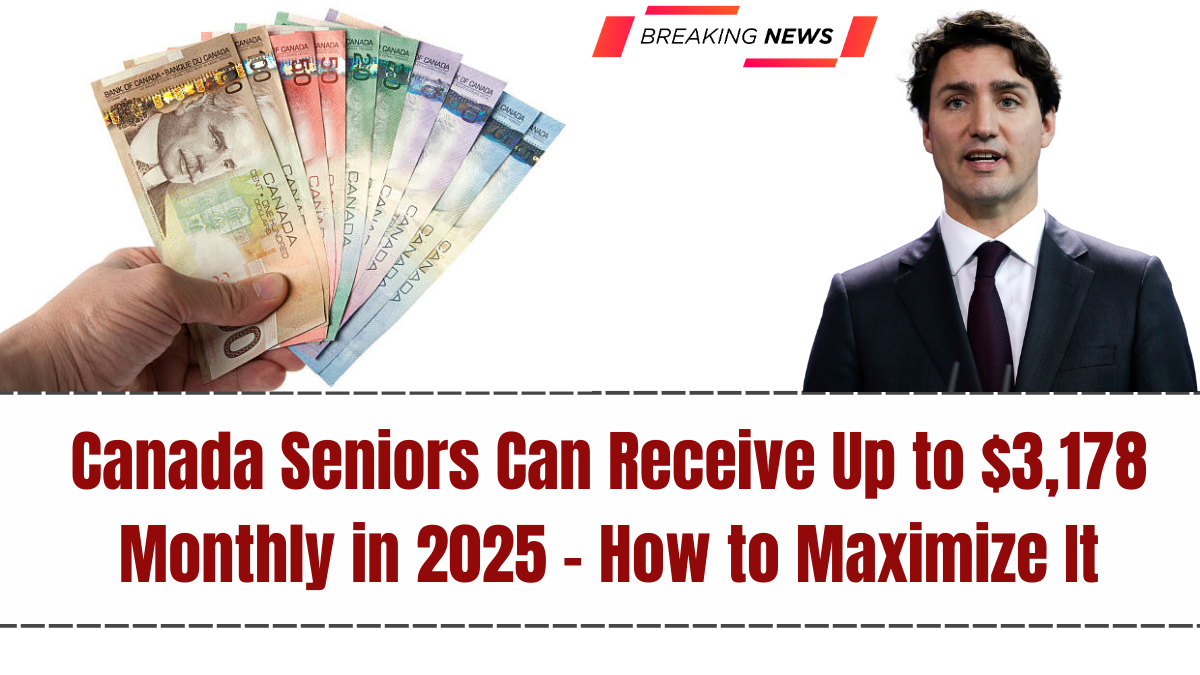Retirement in Canada can feel financially uncertain, especially with rising living costs and healthcare expenses. To ease the burden, seniors are supported by a combination of federal programs, including the Canada Pension Plan (CPP), Old Age Security (OAS), and the Guaranteed Income Supplement (GIS). In 2025, the maximum combined benefits for eligible seniors can reach up to $3,178 per month, provided they qualify for the highest amounts under each program.
While not every retiree will receive the full figure, understanding how these benefits work—and how to maximize them—can make a significant difference in retirement income.

Breaking Down the Benefits
The $3,178 maximum monthly amount in 2025 comes from combining three main streams of support:
-
Canada Pension Plan (CPP)
-
Maximum monthly CPP retirement pension at age 65 in 2025: $1,364.60.
-
Based on lifetime contributions. Workers who contributed the maximum amount throughout their careers qualify for this top rate.
-
-
Old Age Security (OAS)
-
Maximum monthly OAS pension at age 65 in 2025: $713.34.
-
Available to most Canadians who have lived in the country for at least 40 years after age 18.
-
-
Guaranteed Income Supplement (GIS)
-
Maximum monthly GIS for single seniors in 2025: $1,100.44.
-
Income-tested benefit, meaning only low-income seniors qualify for the full amount.
-
Adding these together gives a potential monthly total of $3,178.38, or more than $38,000 annually.
Who Can Qualify for the Maximum?
Not all seniors will reach the maximum level. To qualify, an individual would need:
-
A full CPP contribution history, usually by working consistently at or near the maximum pensionable earnings for 39+ years.
-
Eligibility for the full OAS pension, requiring 40 years of residency in Canada after age 18.
-
Low enough annual income to qualify for the maximum GIS.
Because CPP and OAS are widely accessible but GIS is income-tested, only seniors with limited other income sources—like those without workplace pensions or major investments—will receive the maximum $3,178 per month.
How to Maximize Your Retirement Benefits
There are several strategies retirees can use to increase their monthly income:
-
Delay CPP or OAS: By delaying CPP or OAS past age 65 (up to age 70), seniors can receive significantly higher monthly payments. CPP grows by 8.4% per year of delay, while OAS increases by 7.2% per year.
-
Contribute consistently to CPP: Workers should aim to contribute at or near the yearly maximum pensionable earnings. Gaps in employment or low-income years reduce CPP amounts.
-
Ensure OAS eligibility: Immigrants or Canadians with time spent abroad should review residency rules to ensure maximum OAS entitlement.
-
Apply for GIS: Seniors with low incomes should always apply for GIS, as it can add more than $1,100 per month in 2025.
By planning strategically, retirees can get closer to the maximum available income.
Why These Benefits Matter
With inflation affecting groceries, rent, and medical costs, government benefits remain a cornerstone of retirement planning. For many seniors, private pensions or retirement savings are limited. The combination of CPP, OAS, and GIS provides a predictable and stable source of income.
These programs also play a critical role in reducing senior poverty rates. Without them, far more elderly Canadians would struggle to afford housing, medication, and daily essentials.
Challenges Seniors Face in 2025
Despite the potential $3,178 maximum, most seniors receive much less. The average CPP payment in 2025 is around $860 per month, far below the maximum. Many seniors also do not qualify for full OAS because of shorter residency periods, and GIS only applies to those with very limited income.
As a result, the actual monthly benefit for the average Canadian senior is closer to $1,600–$2,000, depending on personal circumstances.
Additionally, benefits are taxable (except GIS), which means net income may be lower depending on overall earnings. Rising rents, food prices, and healthcare costs still stretch these payments thin.
Planning Ahead for Retirement Security
For Canadians not yet retired, maximizing contributions to CPP and ensuring residency eligibility for OAS are key steps. Those with lower incomes should consider applying for GIS once eligible, as it provides the largest boost for vulnerable seniors.
Financial experts recommend that individuals also build personal retirement savings through RRSPs, TFSAs, or workplace pension plans to supplement government benefits. While $3,178 is a helpful maximum figure, relying solely on public benefits may not cover all expenses in retirement.
FAQs
What is the maximum monthly income a senior can receive in 2025?
Up to $3,178 per month, combining CPP, OAS, and GIS at maximum levels.
Do all seniors get the maximum?
No. Only those with full CPP contributions, full OAS residency, and low incomes that qualify for GIS will reach this amount.
How can I increase my CPP payments?
By contributing consistently throughout your working life and delaying benefits up to age 70.
Is GIS taxable?
No. GIS is non-taxable, but CPP and OAS are subject to income tax.
What is the average senior benefit in 2025?
Most seniors receive between $1,600 and $2,000 per month, depending on eligibility.
Click here to know more.




